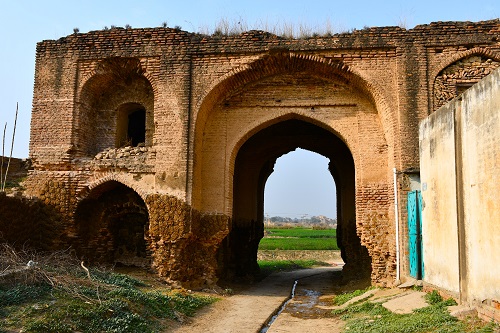
This caravanserai is one the oldest and grand structures in the Gujar Khan Tehsil, which is believed to have been built during the reign of Emperor Akbar
By Zulfiqar Ali Kalhoro
I have been to the historic Sarai Pakka Khanpur several times. It is located about 10 km north of Gujar Khan town. I first visited the Sarai Pakka Khanpur in 2005 and revisited it in 2008, 2009, and 2019 respectively. The last time I visited Sarai Pakka Khanpur was on 15 February 2021 with Muhammad Hanif Hanfi, a poet of Punjabi Pothohari and the author of many books. Muhammad Hanif Hanfi also knows the oral history of the villages that are located near his own village Changa Maira. He has also been one of the few poets of Gujar Khan who has written on Sufi saints and shrines, but mainly on the Naushahiyya (named after Muhammad Naushah Ganj Bakhsh Qadiri (d.1654)), a branch of the Qadiriyya order; the Pirashahiyya (named after Pira Shah Ghazi Qalandar (d.1742)), a branch of the Qadiriyya order; and Baba Fazal Shah Kalyami, a Chishti Sabiri saint whose shrine is located at Kalyam in Gujar Khan tehsil.
Naturally, Muhammad Hanif Hanfi is a good guide to various religious and historical structures in the Gujar Khan Tehsil.
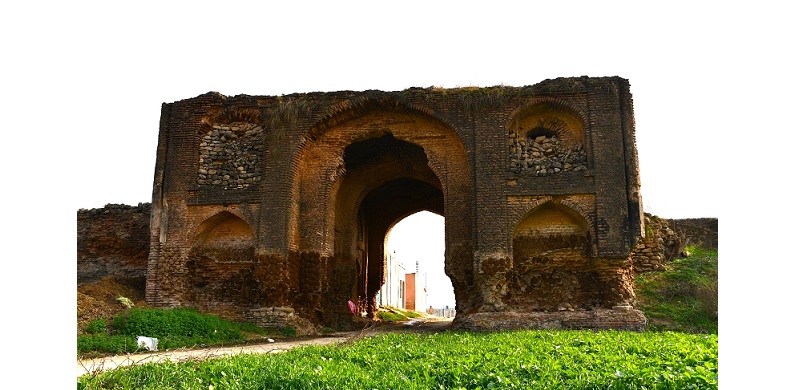
This caravanserai is one the oldest and grand structures in the Gujar Khan tehsil, which is believed to have been built during the reign of Akbar (d. 1605) under the supervision of Sultan Jalal Khan Gakhar.
It is believed that Sultan Jalal Khan Gakhar built Sarai and Pakka houses and held his court there regularly
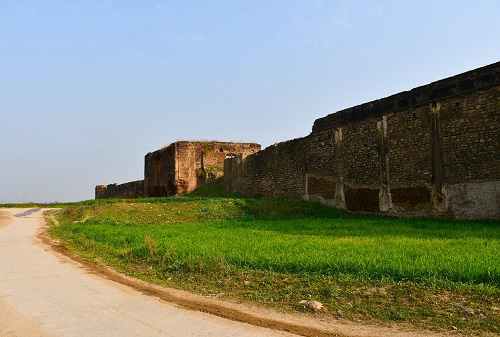
According to Raizada Brijnath, the author of Waja Tasmia Dehat Pargana Dangali wa Pharwala, Sarai Pakka Khanpur is a historical village that was destroyed and founded twice. Last time it was founded by Lango Khan in memory of his father Pakka Khan during the reign of Sultan Adam Khan Gakhar. Langho Khan belonged to the Matial tribe. Therefore, the village came to be called Pakka Khanpur after Pakka Khan. The question remains open as to whether it was named after Pakka Khan or an analogy drawn from burnt bricks or stone blocks which were used to construct this caravanserai.
It is believed that Sultan Jalal Khan Gakhar built Sarai and Pakka houses and held his court there regularly. Hence it was named after him as “Pakka Khanpur or Khanpur Pakka”. Raizada Brijnath believes that there resided about 72 castes in Pakka Khanpur village.
Sultan Jalal Khan Gakhar, who supposedly built the caravansarai, served the Mughal Emperor Akbar (d. 1605) and his son Jahangir (d. 1627). Tuzuk-e-Jahangiri states that Sultan Jalal Khan Gakhar was known for his great benevolence. During a famine in his country, he saved thousands from perishing by distributing food and money. According to Kai Goharnama by Raizada Diwan Dhuni Chand, Sultan Jalal Khan Gakhar died in 1028 AH/1618 AD in a military expedition against the Afghans in the trans-Indus region, which was conducted under the command of the Emperor Jahangir.
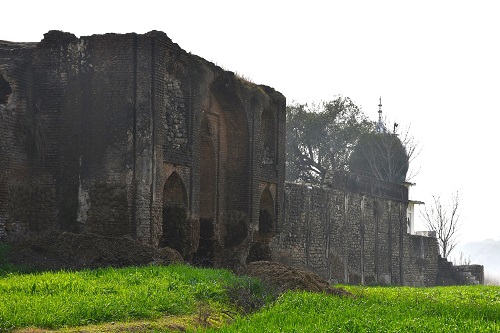
According to Muhammad Hanif Hanfi, the author of Ruh Da Rishta, Raja Changa Khan Bangial Raja Sabbar Khan Bangial, Raja Rakha served Sultan Jalal Khan Gakhar. All three brothers were given jagirs by Sultan Jalal Khan Gakhar, and they founded the villages Changa Bangial, Sabbar and Rokhia respectively.
The Sarai Pakka Khanpur is located on the old G.T Road. Dr. Saifur Rahman Dar (1994) also discusses this route in the article “Caravanserais along the Grand Trunk Road in Pakistan: A Central Asian Legacy,” which is published in the Journal of Central Asia (now the Journal of Asian Civilizations). He believes that from Sar Jalal Khan, an ancient road used to go to Rohtas on the one hand and another to Rawat passing by Dhamaik, Hathia, Mahsa, Pakka Sarai and Kallar Syedan. The latter reaches Rawat where the modern G.T. Road meets the ancient G.T. Road. I have visited many baolis, water tanks, tombs, mosques, temples and samadhis on this ancient route. A majority of the monuments have been either renovated or have disappeared now.
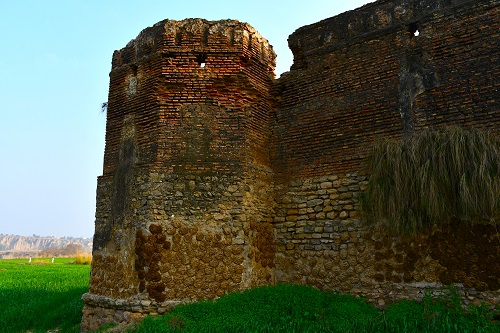
The Sarai Pakka Khanpur is oblong in shape. The main double-story northern portal of Sarai opens to the spacious courtyard where now one can see the houses of immigrants who came to settle in the Sarai after the partition of 1947. Sarai Pakka Khanpur is a grand structure. There are four bastions in the Sarai Pakka, which are crumbling. Staircases lead to the top of each of the bastions and the main entrance. The southern and western bastions are in a bad state of preservation. Even the southern, western and eastern ramparts of the Sarai are partially collapsed. Only the northern rampart is extant and in a fairly good condition.
There was an old mosque and well inside the Sarai. Today, one can only see the remains of the mihrab of the old mosque. A new mosque has also been built by the residents of the Sarai. The well is still extant and is located close to the main entrance of the Sarai. However, Dr. Saifur Rahman (1994) believes that there were two mosques in Sarai Pakka: one for men and the other for women respectively. According to him, a mosque built for women is in ruins, while the one built for men was completely rebuilt. Both were single-chambered mosques.
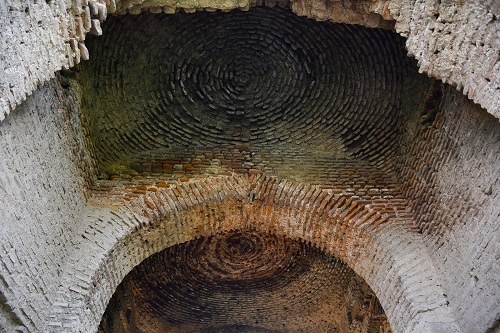
There were also living cells in the Sarai which have now been modified by the residents of the Sarai. Moreover, a majority of the cells are in a bad state of preservation. This Sarai was also used by Afghans and Sikhs for some time.
There is also the shrine of Qazi Muhammad Yar Qadiri, who died in 1860 as per the inscription on the façade of the tomb. As per the inscription, the foundation of the tomb was laid by Pir Syed Sidique Shah of Gulyana Sharif in 2000. This saint is venerated by the local community.
There are the remains of the historic Eidgah, half a kilometer to the west of the Sarai, which was also built at the same time when the Sarai was built.
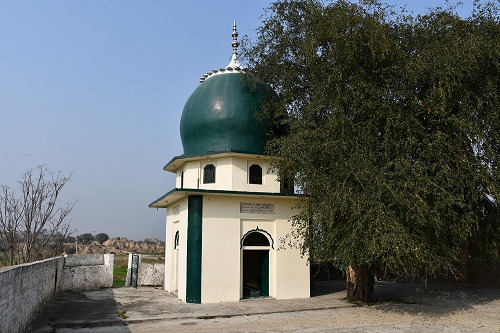
Sarai Pakka Khanpur should be promoted as a potential tourist destination, which may boost the local economy if it is properly promoted. Unfortunately, no information on directions to the site is provided. Even guide boards along the G.T Road – and especially in Gujar Khan town – to the site are missing.
At the very least, direction boards in Gujar Khan town, for travelers to turn on to the Gujar Khan-Beval Road to finally get to Sarai Pakka Khanpur, should be installed.
_______________
 Dr. Zulfiqar Ali Kalhoro, an anthropologist, has authored more than 12 books: ‘Symbols in Stone: The Rock Art of Sindh’, ‘Perspectives on the art and architecture of Sindh’, ‘Memorial Stones: Tharparkar’ and ‘Archaeology, Religion and Art in Sindh’. He may be contacted at: zulfi04@hotmail.com
Dr. Zulfiqar Ali Kalhoro, an anthropologist, has authored more than 12 books: ‘Symbols in Stone: The Rock Art of Sindh’, ‘Perspectives on the art and architecture of Sindh’, ‘Memorial Stones: Tharparkar’ and ‘Archaeology, Religion and Art in Sindh’. He may be contacted at: zulfi04@hotmail.com
Courtesy: The Friday Times Naya Daur Lahore (Posted on April 2, 2023)